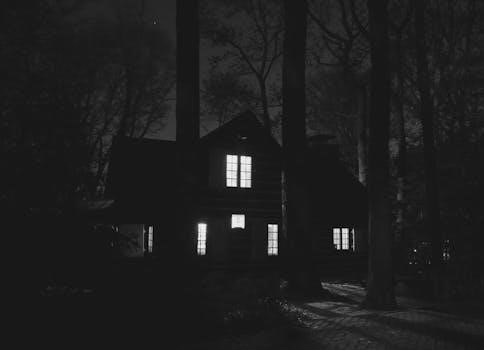The cherished first book of the ‘Little House’ series, Little House in the Big Woods, introduces readers to the Ingalls family. This autobiographical novel, set in 1871, paints a vivid picture of pioneer life through the eyes of young Laura. Available in various PDF formats, it is a timeless classic.
Overview of the Book
Little House in the Big Woods, the inaugural novel in the beloved ‘Little House’ series, offers a captivating glimpse into the early life of Laura Ingalls Wilder. This book, first published in 1932, recounts her experiences growing up in a log cabin in Wisconsin during 1871. It provides a charming portrayal of daily life, family bonds, and the challenges of frontier existence. The narrative follows four-year-old Laura as she navigates the world around her, surrounded by her loving family and the vast, untamed woods. Often accessible in PDF format, this book continues to enchant generations with its warmth and simple storytelling. This version is often available with or without Garth Williams’ illustrations.
Laura Ingalls Wilder, the author of Little House in the Big Woods, was born in 1867 and drew upon her own childhood experiences to write the ‘Little House’ series. This book, like the others, is deeply rooted in her memories of frontier life, offering an authentic glimpse into the past; Her simple yet evocative writing style has captivated readers for generations, making her a beloved author of children’s literature. Wilder’s storytelling is also noted for its educational value, as it reveals the homesteading skills and challenges of the time. Her work is widely available, and digital formats, like PDF, have made her books easily accessible to a broad audience.
Setting and Time Period
Little House in the Big Woods is set in 1871, in the deep woods of Wisconsin. This time period and location are crucial, shaping the family’s daily life and experiences.
Wisconsin Big Woods in 1871
The narrative of Little House in the Big Woods unfolds amidst the dense and untamed Wisconsin wilderness of 1871. This setting is not merely a backdrop but an integral part of the story, influencing the Ingalls family’s daily existence. The vast, deep woods, teeming with wildlife, including wolves, panthers, and bears, present both challenges and opportunities for the homesteaders. The isolation and natural beauty of this specific time and place profoundly shape the experiences and lessons within the book, highlighting the pioneer spirit and resourcefulness required for survival in the American frontier. The year 1871 marks a distinct era, adding historical context to the family’s life.
Description of the Log Cabin
The Ingalls’ log cabin stands as a central symbol in Little House in the Big Woods, representing safety and family unity. Constructed from sturdy logs, the small gray house provides shelter against the harsh elements and surrounding wilderness. The cabin, snug and secure, is nestled deep within the Wisconsin woods, far from any neighbors, highlighting the family’s self-sufficiency and reliance on their own resourcefulness. The cabin’s interior, with its simple furnishings and warm hearth, forms the setting for much of the family’s daily activities. The log cabin is more than just a dwelling; it is a place of comfort, love, and the foundation for family life in the Big Woods, providing a sense of security amidst the wild landscape.

Characters
The novel features the Ingalls family⁚ Laura, a young, curious girl; her older sister Mary; baby Carrie; their strong Pa, and their loving Ma. The family dog, Jack, is also a key character.
Laura Ingalls
The story is told from the perspective of Laura, a spirited and observant four-year-old girl at the beginning of the novel. She is portrayed as curious and eager to explore the world around her, especially the natural beauty of the Big Woods of Wisconsin. Laura’s experiences and interactions form the core of the narrative, and the readers witness her development and growth through her daily life. Her sense of wonder and adventurous spirit make her a relatable character to readers of all ages. Laura’s perspective provides an intimate glimpse into the routines and challenges of pioneer life, making her a memorable protagonist.
Pa, Ma, Mary, and Carrie
The Ingalls family, consisting of Pa, Ma, Mary, and baby Carrie, forms the close-knit unit at the heart of the story. Pa is portrayed as a capable and resourceful man who provides for his family through hunting, trapping, and farming. Ma is a loving and diligent homemaker, skilled in various domestic arts. Mary, Laura’s older sister, is gentle and well-behaved. Baby Carrie is the youngest member of the family, often the center of attention. Together, they create a warm and supportive family environment, showcasing strong bonds and interdependence in their daily lives within the Big Woods.
Family Dog, Jack
Jack, the family’s loyal bulldog, is an integral part of their lives in the Big Woods. He is more than just a pet; he’s a protector and companion, often depicted as being close to the children. Jack adds an element of safety and comfort to their isolated existence, guarding the family and their cabin. His presence emphasizes the importance of animals in a homesteading life, where they contribute to security and companionship. Jack’s devotion is a recurring theme, highlighting the bonds between humans and animals in this challenging setting. The digital editions often include illustrations featuring Jack, further enriching his character for readers.

Themes and Content
The book explores themes of self-sufficiency and resilience. It highlights the daily routines, homesteading skills, and the close-knit relationships of a pioneer family, all within the context of their life in the Wisconsin woods.
Daily Life in the Woods
The narrative vividly details the daily existence of the Ingalls family in their secluded log cabin. From the simple chores like churning butter and making cheese, to the more complex tasks of hunting and preserving food, the book showcases the rhythm of their lives. Laura’s days are filled with both domestic duties and the excitement of exploring the surrounding wilderness. The text also captures the family’s interaction with the natural world and the challenges faced by living remotely, highlighting their resourcefulness and adaptability in the Wisconsin woods, with dangers such as wild animals being a constant concern. The descriptions paint a picture of both the beauty and the hardships of their daily routines.
Homesteading Skills
The book provides a detailed look into the homesteading skills crucial for survival in the Big Woods. Readers witness Pa’s expertise in hunting and trapping, which provides essential food and fur. Ma’s skills are equally emphasized, from her cheesemaking and preserving to her crafting of essential household items. These hands-on activities, like making sugar and creating clothes, highlight the self-sufficiency of the family. The novel illustrates the importance of ingenuity and hard work in managing a home in a remote location; The text also captures Laura’s early experiences learning these skills, offering a glimpse into the practical education of pioneer children, all while PDF versions make this accessible to modern readers.
Family Relationships
The narrative underscores the strong bonds within the Ingalls family. The book showcases the deep love and respect between Pa and Ma, highlighting their collaborative efforts in providing for their children. The relationship between Laura and her sisters, Mary and Carrie, reveals the dynamics of siblinghood in a close-knit environment. The family’s interactions, from everyday chores to special occasions, reveal a profound sense of unity and mutual support. This warmth of familial love helps them navigate the hardships of frontier life together. The PDF versions of the book provide an opportunity to experience these moments again. The text also demonstrates the children’s respect for their parents.

Editions and Formats
Little House in the Big Woods is widely available in print, ebook (PDF and EPUB) and audiobook formats. Many editions include illustrations by Garth Williams or Helen Sewell, adding to its charm.
Print Editions
Little House in the Big Woods has seen numerous print editions since its initial publication in 1932. These editions often vary in cover art and included illustrations. Some notable printings include those with the iconic artwork of Garth Williams and Helen Sewell. These print versions are widely available, offering a classic reading experience for those who prefer a physical book, with varying sizes and formats that cater to different age groups and collector interests. The charm of holding a tangible copy adds to the nostalgic appeal of this beloved story, making it a timeless treasure for generations.
Ebook Versions (PDF, EPUB)
Little House in the Big Woods is widely accessible in digital formats, including PDF and EPUB, catering to modern readers. These ebook versions allow for convenient reading on various devices like tablets, smartphones, and e-readers. The PDF format often replicates the layout of the print edition, while EPUB offers adjustable text sizes and formatting. Many platforms offer free or affordable downloads of these ebooks. Some digital editions feature the original illustrations by Garth Williams or Helen Sewell, enhancing the reading experience. The flexibility of ebooks makes this classic accessible to a new generation of readers, no matter their location or device preference;
Illustrated Editions by Garth Williams and Helen Sewell
The visual appeal of Little House in the Big Woods is significantly enhanced by the inclusion of illustrations. Garth Williams and Helen Sewell are two notable illustrators who have brought the story to life through their unique artistic styles. Garth Williams’ illustrations, often featured in digital versions, capture the warmth and rustic charm of the Ingalls’ life. Helen Sewell’s artwork, also beloved by readers, provides a different perspective, adding to the charm of this classic tale. These illustrated editions, sometimes available in color on modern devices, greatly enrich the reading experience, making the story more engaging for children and adults alike.

Availability and Access
Little House in the Big Woods is widely accessible. Numerous online platforms offer free eBook downloads, including PDF versions. Audiobook options further enhance its availability, catering to diverse preferences and needs.
Online Reading Options
Numerous websites provide online reading options for Little House in the Big Woods, allowing readers to access the full text directly through their web browsers. These platforms often offer a user-friendly interface, making it convenient to navigate the chapters. Some sites also include additional features like page turning animations and adjustable font sizes for comfortable reading. Furthermore, online reading eliminates the need to download a file, providing immediate access to the story. Many of these options are free, making the book readily available to a wide audience. These platforms often provide summaries and reviews alongside the online text.
Free eBook Downloads
Many reputable sources offer free eBook downloads of Little House in the Big Woods, often in PDF format, making it accessible to a wide range of readers. These free downloads are usually provided by platforms dedicated to preserving classic literature or offering educational resources. Some versions may include the original illustrations by Helen Sewell or Garth Williams, enhancing the reading experience. These downloadable eBooks enable readers to enjoy the story offline on devices like tablets, eReaders, and computers. It’s important to verify the legitimacy of the source to ensure a safe and complete download of the book.
Audiobook versions
Besides PDF versions, Little House in the Big Woods is also available in audiobook format, providing an alternative way to experience the story. Audiobook versions are often narrated by talented voice actors like Cherry Jones and Regina Reagan, bringing the characters and setting to life. These audiobooks can be found on platforms like LibriVox, which offers free recordings of classic books, and other commercial audiobook services. This format is perfect for listening on the go, making it a convenient option for those who prefer auditory learning or have difficulty reading. The audiobook allows a different engagement with the text.